MONASH UNIVERSITY STUDENT HOUSING, CLAYTON
BVN Architecture
Upon receiving funding approval, through NRAS (National Rental Affordability Scheme), to build 600 student residences, Monash University engaged BVN Architecture, and its project team, to work to a brief that required:
- Fit for purpose, quality low cost housing, including 600 self contained single occupancy units (SOUs), two manager’s residences (3bed) and two deputy manager’s residences (2bed);
- 2 buildings each containing 300 students;
- A sense of community through the provision of adequate common spaces and the composition of residential and non residential areas;
- A collegiate environment;
- Highly flexible, reconfigurable, intuitive space;
- Sustainable, safe, high performance buildings with 5 Star Green Star – Multi Residential project rating;
- A home, not just a repetitive, impersonal container for 600 rooms.
A key requirement of the funding was that the housing was to be delivered within 2 years which meant designing for D&C tender within a 12-week period, after which the project was to be constructed within 18 months. It was necessary to develop a design that was robust, repetitive (simple to build with the potential of lending itself to both conventional and modular construction), whilst also meeting its key objective of becoming a place that is great to live, and meeting Monash University’s residential model which includes high standards of pastoral care.
This project has achieved a 5 star Green Star As Built rating and is the first multi-residential project to do so in Australia. The project was also awarded a 5 Star Green Star As Designed rating as part of the environmental rating process.
INITIATIVES
-
An energy consumption and WOL (whole of life) assessment was also undertaken to determine the best method of heating the halls of residence and it was determined that hot water heated radiant panels (supplied by gas heated water) would give the most effective result. Having almost completed their first winter, the buildings are testament to the success of this system which is also thermostatically connected to a shut off device which closes it down once outdoor temperatures get above a predetermined level.
-
The building is constructed of a robust and simple materials palette including exposed unfinished concrete and untreated spotted gum cladding and sunshading (sourced from South QLD) that will grey off naturally and not require maintenance. These materials were chosen as they are suitable to the local climate and sit well within the relatively low density landscape building setting.
-
Roof rainwater is collected, stored in 3 x 50,000 litre tanks and used for toilet flushing, laundries and landscape irrigation. Grey water from laundries, bathroom basins and showers is also collected, processed and reused for toilet flushing and laundries. Over 2,000m2 of solar roof panelling, one of the largest residential solar installations in the Southern Hemisphere, reduces energy consumption and the associated reflectivity reduces thermal impact.
-
All electrical appliances carry the highest available Energy star ratings and all plumbing fittings carry high WELS star ratings. A master switch to each apartment ensures all lighting and ceiling fans can be turned off upon entry and exit. An electronic display system is used to monitor residents’ energy consumption.
-
Timber screens shade full height glazing to central communal spaces with battens spaced according to their solar orientation. Elsewhere, facade articulation provides shading to each apartment.
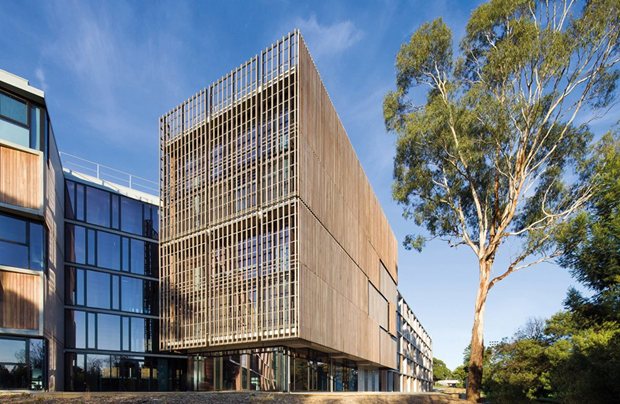
-
The use of double glazed operable facades, trickle intake ventilation and thermal chimneys provide natural ventilation. Mechanical heating and cooling have been deleted entirely. All heating is provided through gas boosted radiant water heated panels. Ceiling fans aid natural ventilation. The base building also includes significant amounts of exposed structure.
-
Environmentally innovative products were consciously specified wherever possible to reduce the building’s impact on the environment and improve indoor environment quality.
-
Materials used for joinery, flooring and internal walls include extensive third-party accredited and low VOC products that reduce their environmental impact.
-
The environmental products that were incorporated in the design included:
- CSR Gyprock (internal wall linings)
- Laminex FSC timber veneer (internal feature wall linings)
- Laminex Whiteboard MR E0 (joinery carcasses)
- D&R Henderson Decoline White (joinery carcasses)
- Interface Flor Continuum Carpet Tiles (flooring)
- Exposed concrete floors
- Minimisation of PVC content
-
Recyclable building practices were used on site by the head contractor. A waste management plan was implemented and waste records were kept and reported on a quarterly basis. 80% of all construction waste was recycled.
-
The landscape has been designed to reduce run-off through a selection of surface materials and appropriate planting. An Environmental Management Plan was implemented to protect the neighbouring nature reserve.
-
General, paper and hard waste is recycled to reduce landfill. The project is located close to a range of campus amenities and academic facilities to reduce reliance on travel and associated CO2 emissions.
ACCOMMODATION FOR PEOPLE WITH DISABILITIES
cmsArchitects
The brief was to provide three dwellings to the site to accommodate people with disabilities.
The adopted design concept takes advantage of the topology of the site, with units and paving following the site slope down the site. The design employs a “single level” approach to the floor plan and maintains the height and form similar to nearby dwellings. The design of the elevation reflects the predominate form of the streetscape with entry verandahs. The main construction material is timber frame with lightweight cladding, including cement sheet and hardwood shiplap boards.
The units embrace the view over the gully, with distant views of hills and farmland. Living areas are designed to increase the perceived size of the space, so the units feel much larger than the floor area suggests. Circulation space, door and window placement, fully accessible bathroom, laundry and open kitchen, all work to provide an accessible environment. The client did not consider it necessary to provide a fully accessible kitchen.
The site is elongated, has a basic rectangular shape, with an angled corner on the northeast. Its South frontage faces Raglan Street. It has an approximate area of 905m², although much of this is restricted by easements. The land steeply slopes to the North East of the lot. The site and the surrounding locality can be described as hilly starting low at the creek valley and rising to the west and South.
The site has a required setback of 6.4m. The rest of the street has a generally consistent front setback of 7m or more.
INITIATIVES
-
Roof heights and overall bulk have been selected to match predominate single storey buildings and at the same time provide visual interest to the streetscape. The selected materials & design comply with the requirement of BAL 12.5.
-
Due to the orientation and high levels of insulation, the units achieve up to 6.6star energy rating (minimum of 6.1star).
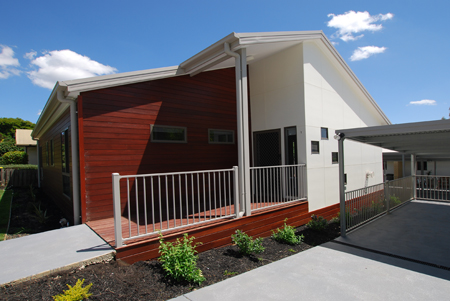
-
Each unit receives excellent northern orientation, with solar gain controlled by adequate eave overhang, which allows good sun penetration in the winter. North facing decks provide directly accessible open space for each unit. With weather protected space for units 2 & 3.
-
Each unit is provided with a 4500L rainwater tank, for Laundry and automated Garden irrigation. Storage sheds and tanks are concealed under decks to reduce leaf and debris accumulation, thereby reducing fire exposure.
-
Roof spaces are ventilated to reduce heat load on the internal rooms. Gas boosted, Solar hot water units are provided. Four star water saving plumbing outlets are used.
-
Energy saving gas space heaters are used, and all floors are insulated to R3 level.
LOCHIEL PARK AFFORDABLE APARTMENTS
Greenway Architects
The project brief called for 23 apartments and townhouses to meet the stringent Lochiel Park Design Guide set by LMC, covering the Lochiel Park Eco Village. We started with a floor plan that is intentionally simple, with all living spaces and balconies facing north and an internal communal carpark which links to community gardens and wetlands, with climbing plants screening the east and west facades. The environmental aspirations are figuratively represented by a brightly coloured triangular roof which links the apartment blocks and holds the numerous photo voltaic panels for electricity collection and solar hot water. Greenway developed an innovative natural ventilation system providing passive cross ventilation to each residence. A ventilation stack positioned centrally in the apartment is assisted by a roof mounted rotary ventilator, and is controlled via motorised louvres linked to the AC system. In addition to the technology, careful selection of building materials and finishes has been undertaken to maintain a consistent Eco approach across the entire development.
The Affordable Apartments at Lochiel Park were designed to be a showcase for effective passive environmental design, showing that medium density infill housing can be affordable, green, and community oriented. The concept provides efficient housing on a challenging site backing onto the O-Bahn, with the sustainable goals of the village community overtly expressed through the representative device of the angular roof form. Three townhouses are designed to suit Housing SA tenants, with adaptable standard bathrooms and kitchens for accessibility. All rainwater is collected and each residence achieves at least 7.5 stars when assessed against AccuRate, with energy use monitored thru a communal resource monitoring system.
INITIATIVES
-
All rainwater is collected in two large underground tanks and connected to the solar hot water units (grouped together in blocks of 3 or four).
-
Recycled (ASR) water in lilac piping is used for toilet flushing and irrigation, and will be drawing water from the adjacent wetlands.
-
Mains water is also connected for cold water use.
-
Each apartment has pulse metering to all water supplys (and gas) to provide realtime feedback of water consumption (via the Ecovision monitor).
-
The EcoVision 3010 is an integrated water, gas and electricity resource monitoring system and an integrated Load Management Device. The intent of the installation of EcoVision is to provide information to the residents on the usage of resources at both a micro and a macro level.
-
Greenway developed an innovative natural ventilation system providing passive cross ventilation to each residence, reducing the need for air conditioning. A ventilation stack positioned centrally in the apartment is assisted by a roof mounted rotary ventilator, and is used in combination with the external opening windows in the living spaces and bedrooms. Ventilation is controlled via motorised louvres linked to the AC system.
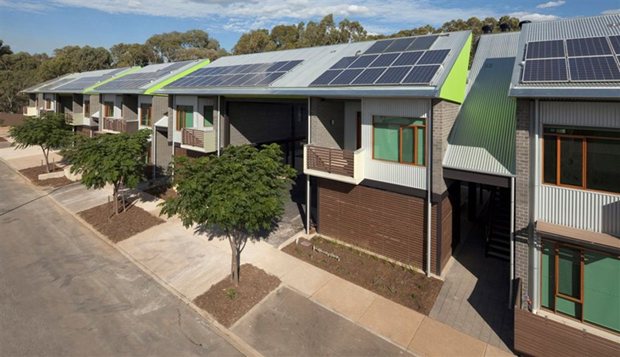
-
In addition to the technology of the services, careful selection of building materials and finishes has been undertaken to maintain a consistent Eco approach across the entire development.
-
The environmental aspirations are figuratively represented by the brightly coloured triangular roof which links the apartment blocks and holds the numerous photo voltaic panels for electricity collection and solar hot water.
-
Each Apartment has a display screen which is mounted on a feature plywood wall in the kitchen area, and the services backbone in the linen press off the hall. The EcoVision 3010 is an integrated water, gas and electricity resource monitoring system and an integrated Load Management Device.
58 STEVENS STREET
Officer Woods Architects
The clients were first time developers; landscape contractors with a sincere environmental consciousness, as well as a canny development eye.
The land had been subdivided into four lots and the clients wanted to build a housing development that could be divided to yield more than four dwellings should the local density code change in the future. They wanted the dwellings to be designed to be both flexible and adaptable to accommodate the changing demographics of our future population, family structures and the ability to support intergenerational living arrangements. The brief also called for sustainable building practices, materials and finishes, minimal ongoing maintenance and costs and long life cycle.
INITIATIVES
-
Mandatory energy efficiency requirements of the local council, state residential design codes and BCA were met and surpassed.
-
Each house has a 2Kw PV array for solar power generation and low energy fixtures and lighting. Rainwater is harvested from all roofs and collected in four 3000l tanks which are plumbed to all WCs and washing machines for reuse. Each house is double plumbed for grey water recycling. All fittings are 4 star or greater WELS rated water efficient. Waterwise gardens have been planted with extensive endemic coastal native species.
-
The key innovation was flexibility and long term adaptability of the dwellings. One of the ways of achieving this was by separating vehicle and pedestrian access. This had a threefold effect; pedestrian safety, a more communal entry sequence and a way of entering each house at both ends, to facilitate future internal subdivision.
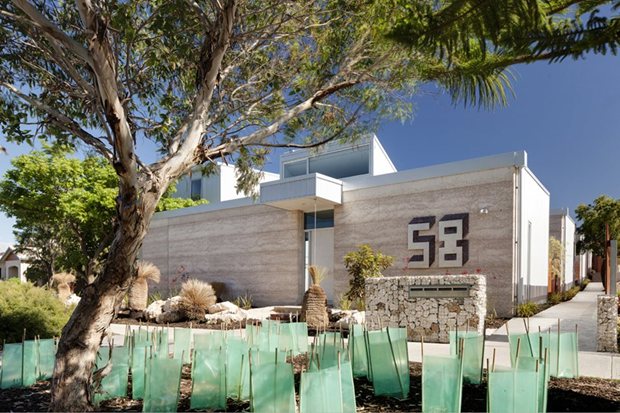
-
In all standard configurations, garages have been prepared with finished slabs, linings and prewiring for easy conversion to home offices or commercial shopfronts, encouraging blended live work arrangements. A central nib wall has been serviced with gas, water, power and plumbing, so that each house may be easily and affordably divided in the future to accommodate an additional bedroom or completely separate self contained dwelling with its own entry.
-
Eco blend concrete for footings and slabs, Low E glazing, local timber veneer on E zero particleboard and natural stone for cabinetwork, natural Albany wool wall and ceiling insulation, Aircell roof insulation, Livos timber sealer, Agar first base concrete sealer, 4 star or greater WELS rated fittings and fixtures, LED lighting throughout.
-
Recycling was crucial to the construction process, where an innovative model was piloted by Earthcare Recycling with waste sorting and separation conducted on site in mini bins which allowed 80% of the building waste to be recycled and diverted from landfill.
-
The houses are built on reclaimed rather than clean fill.
-
Low embodied energy mass walls, made of rammed recycled building rubble (most of it from the demolished bungalow previously on the site) are located on the southern boundaries to provide thermal storage as well as retaining, acoustic and fire separation.
-
An eco-blend concrete was used for all ground floor slabs. Additionally, jarrah floorboards from the demolished original cottage are reused in the upper floor bedrooms and studies.
-
All existing mature trees and a large portion of limestone rubble on site have been retained and/or relocated.
-
Engineers at the Perth-based eTool carried out a life cycle assessment (LCA). eTool found that the development is close to carbon neutral, representing a reduction of about nine tonnes of CO2e per annum per dwelling.
-
The dwellings have been designed to facilitate multiple modes of occupation over time with only minor modifications required for reconfiguration for home office, granny flat or additional bedrooms; a truly sustainable model for infill housing.
GATEWAY
Level Architekture
The brief was to build apartments or townhouses for the client and his three sons.
The project was under a heritage overlay and an environmental overlay as the original building was a factory
INITIATIVES
-
An independent and the council heritage advisor were engaged to produce a contemporary project but that was sympathetic with its surroundings. We worked closely with environmental engineers to address the removal of the soil contamination
-
Passive design that includes orientation, natural ventilation and insulation to reduce the use of mechanical energy was taken into consideration.
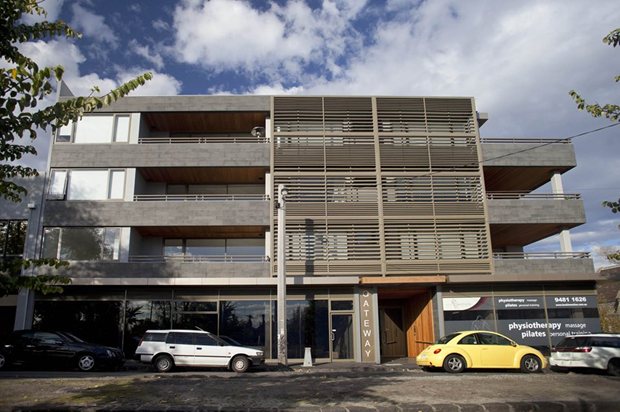
-
Water has been harvested from roofs into a large concrete tank in the basement.
-
All appliances and other equipments have been selected for their high star rating, energy efficient lighting has been specified.
-
The use of passive design and working closely with all consultants from the beginning of the project
-
Building products were sorted prior to be disposed or gone to recycling
-
High performance double glazing, special taps, solar panels for electrical production and for water heating.

